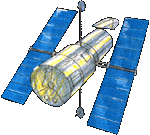
The Hubble Space Telescope is by far the most versatile
instrument presently in orbit. After the recent retrofit, the telescope
can make spectral measurements from the near infrared to the near ultraviolet
parts of the electromagnetic spectrum. It is also capable of taking photographs
in the visible region.
During the 1997 retrofit, the Goddard High Resolution Spectrograph
(GHRS) was removed from Hubble, but until that time, the GHRS made a number
of high-resolution images of UV spectra that gave scientists clues about
the formation of the chemical elements boron and beryllium in supernovae.
The GHRS also detected an aurora on the Jovian moon, Ganymede, and has detected
UV radiation from comets around the star Beta Pictoris.
During the retrofit, a new high-resolution infrared spectrograph
was installed. This instrument, called NICMOS, will examine IR wavelengths
never before observed and may discover new planets orbiting distant stars.
Another new instrument called STIS will be able to make observations in
the visible and near UV wavelengths with greater resolution and in a wider
field.
Created 1997 The Exploratorium
Copyright ©
Regents of the University of California
| 
